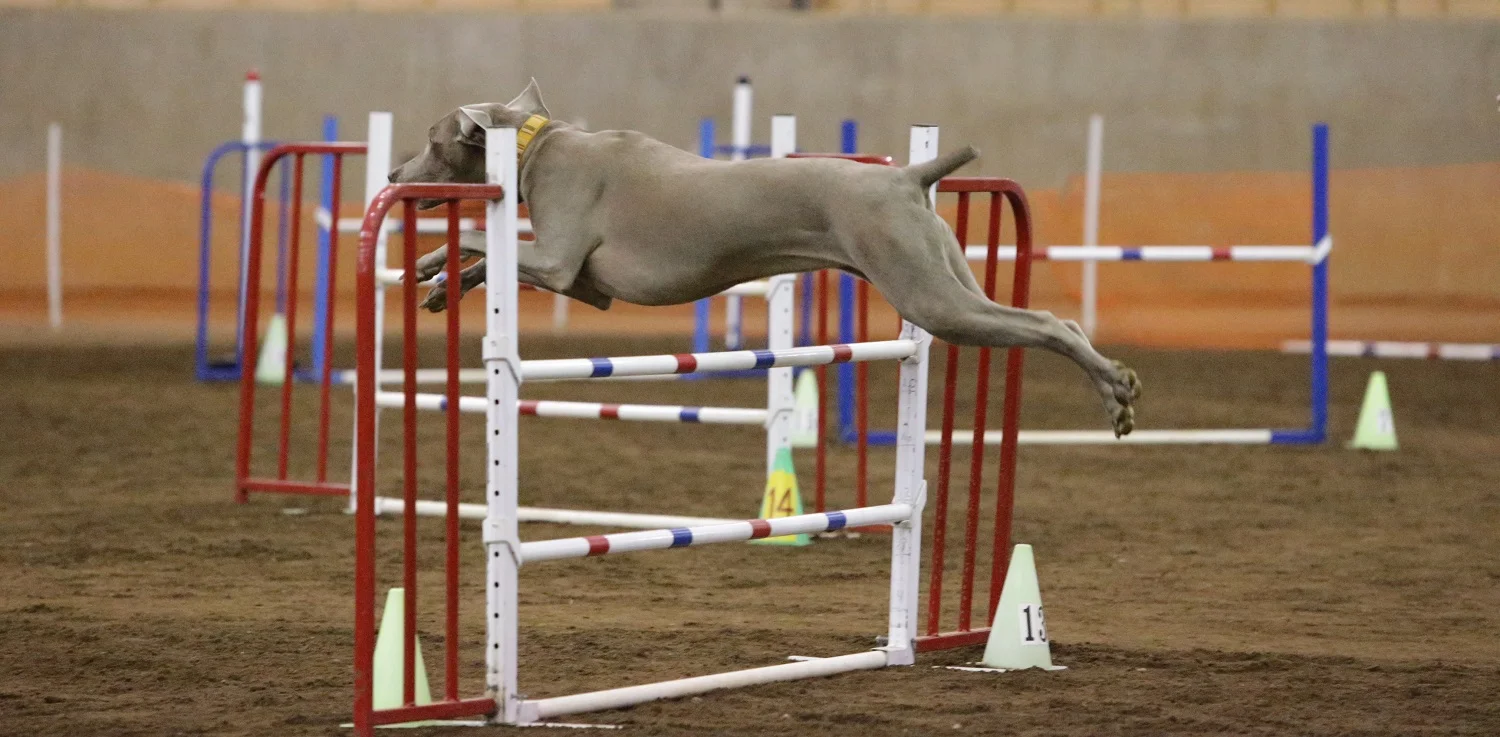About the Breed
A great number of people decide they want a Weimaraner based upon their unusual looks, their unique color, and amber eyes. However, many do not know anything else about the breed, what their personalities are like, what their exercise requirements are, and what motivates their interactions with people. Education is the key component to forging a long and successful relationship with your Weimaraner.
Weimaraners originated in Weimar, Germany in the 1800s and came to the USA in the 1950s. Originally developed to hunt large animals such as stags and wild boar, the Weimaraner was then refined to hunt smaller game, including birds. Although utilized as hunting dogs, the Germans kept their Weimaraners in their homes, believing that if the dogs lived directly with their people they would hunt better for them. As a result, today's Weimaraners demand a tremendous amount of attention and interaction from their family members. Additionally, the hunting instinct is still very strong in these dogs, and many Weimaraners do not do well with cats, small dogs, and other small animals.
Weimaraners are strong, athletic dogs that require intense daily exercise to meet their physical and emotional needs and it is often said that "a bored Weimaraner is a bad Weimaraner". It is not unusual for them to open refrigerators, doors, chew siding off house exteriors, climb fences, etc. They will bark all day and become a nuisance to the neighbors or dig holes if left alone in the yard. Many can be escape artists by climbing fences, digging out from under them or unlatching gates. These stories are told over and over by frustrated owners who do not provide enough physical and mental stimulation for their dogs. Weimaraner owners must plan on being active with their dogs on a daily basis, whether it's walking, jogging, engaging in obedience work, or any type of rigorous training. If you do not lead a particularly active liftestyle, the Weimaraner is not the most suitable breed for you. All Weimaraner owners should expect to participate in obedience classes with their dog.
Weimaraners who have been rescued are often confused and stressed by the recent changes in their lives. Patience, understanding, structure, and stability are key elements in helping a rescued Weimaraner successfully transition into their new family. Establishing boundaries and consistent reinforcement of them allow a dog to understand his/her position in the family and is actually quite comforting. It can take several weeks for a new dog to become fully comfortable in the new environment. Please allow your rescued dog time to develop trust and understanding of his/her new life with you.
Breed Standards...
Appearance
The Weimaraner is a sleek, moderately large, athletic dog with beautiful lines and a short, fine, smooth, gray coat. All shades of gray are accepted. The head and ears are a bit lighter in color than the rest of the body. The head is long and aristocratic and the muzzle is strong. The eyes are amber, blue-gray or gray - with an intelligent expression, and the nose is gray. The ears are moderately long and pendant. The topline slopes gently downward from the withers. The forelegs should be straight with dewclaws removed. The tail is docked to 1½ inches (4cm) when the dog is two days old. The limbs are long and muscular. The Weimaraner has webbed feet for swimming.
Temperament
Happy, loving, cheerful, affectionate, and very rambunctious. Intelligent, but can be highly opinionated and willful, therefore this breed should have firm, experienced training from the start. Quick to learn, but resistant to repetitive training. Reserved with strangers and sometimes combative with other dogs. Socialize them well at an early age. Protective on his own territory. Very brave and loyal, it has a strong prey instinct. Do not trust with small non-canine animals. This is definitely not a herding or farm dog. The Weimaraner needs to live indoors as a member of the family. He needs attention and companionship. If relegated to a kennel life or if left alone too much, he can become very destructive and restless. He is a natural protector. Weimaraners are often kind to children, but are not recommended for very young ones because they are energetic enough to accidentally knock a child down. This breed likes to bark. Very hardy, with a good sense of smell, and a passionate worker, the Weimaraner can be used for all kinds of hunting.
Height, Weight
Height: Dogs 24-27 inches (61-69cm) Bitches 22-25 inches (56-63cm) Weight: Dogs 55-70 pounds (25-32kg) Bitches 50-65 pounds (23-29kg)
Health Problems
As they are prone to bloat, it is better to feed them two or three small meals a day rather than one large meal. They may also suffer from hip dysplasia, but are in general a hardy breed of dog. Hip dysplasia has been reduced to only 8% through conscientious breeding. Prone to hypertrophic osteodystrophy (too rapid growth) and tumors.
Living Conditions
WRS does not recommend most Weimaraners for apartment living. Most Weimaraners will do best with at least a large fenced yard.
Exercise
These are powerful working dogs with great stamina. They need plenty of opportunities to run and get lots of regular exercise. Do not exercise them after meals.
Life Expectancy
About 10-12 years.
Grooming
The smooth, short-haired coat is easy to keep in peak condition. Brush with a firm bristle brush, and dry shampoo occasionally. Bathe in mild soap only when necessary. A rub over with a chamois will make the coat gleam. Inspect the feet and mouth for damage after work or exercise sessions. Keep the nails trimmed. This breed is an average shedder.
